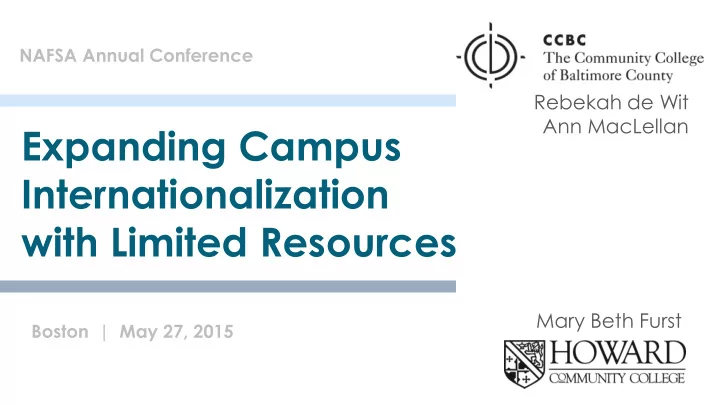

NAFSA Annual Conference Rebekah de Wit Ann MacLellan Expanding Campus Internationalization with Limited Resources Mary Beth Furst Boston | May 27, 2015
1. Intercultural Dialogues Program 2. Global Curriculum Today’s Discussion 3. Global Scholars Program 4. Faculty & Staff Professional Development 5. Case Studies 6. Q&A
From Students Services Success Our Reality: Big Expectations From Administrators Student satisfaction Enrollment/retention Fewer Resources Completion agenda
Increasing enrollment / retention → Attractiveness to prospects Our Goals: → Satisfaction of current students → Helping students to complete College Priorities Raising revenue → To support our own office Fewer Resources → To support the institution
Appreciative Inquiry : Building
Part 1: Intercultural Dialogues
A process that comprises an open and respectful exchange Part 1: Intercultural Dialogues or interaction between individuals or groups with different cultural backgrounds or world views.
Topics: related to the Part 1: student’s home country Intercultural Dialogues or region Format: formal presentation or an informal discussion
Large International Domestic Student Group Part 1: Intercultural Dialogues International Student Credit Class Panel / ESL Class Format & Venues ● Credit classes ● Campus and community events ● Faculty/staff workshops/trainings
● Campus forum during IEW: “Environmentalism Around the World” Part 1: ● Literature class: A Haitian student spoke about two famous Intercultural Dialogues Caribbean authors and how their works are viewed/used in Haiti ● Biology class: Two students spoke Samples about albinism in their home countries
● Cultural psychology class: (whole class match) PSYC students interviewed ESL students about family structures in their home countries Part 1: ● Dance class: A Russian student spoke Intercultural Dialogues about (and demonstrated) Russian hip-hop music and dance traditions ● Online speech class: Two students Samples answered questions in an online forum about communication styles in their home countries
● Staff: minimal intervention and no separate budget required ● Domestic students: realistic, accessible introductions to countries/cultures Part 1: ● Instructors: peer“expert” guest speaker Intercultural Dialogues ● International student speakers: ○ speaking opportunities - both formal and informal Benefits ○ opportunities to show expertise ○ respect from peers ○ interaction with domestic peers
1. Instructor submits speaker request to coordinator. 2. Coordinator contacts corps of student speakers seeking a match for the requested topic and Part 1: date/time. Intercultural Dialogues 3. Coordinator sends student(s’) contact info to instructor. 4. Instructor contacts student(s) Process directly to make arrangements. 5. Student(s) present on the appointed topic and date.
International student speakers: ● International Student & Scholar Office Part 1: ● ESL classes Intercultural Dialogues ● International/global student clubs Recruitment ● Small incentive (e.g., bookstore gift card, extra credit in ESL)
Instructors: ● Announcements ● Departmental and other Part 1: instructor meetings Intercultural Dialogues ● Website ● Participation recognized Recruitment in performance reviews
Part 2: Globalized Curriculum
• History • Geography World • Literature Part 2: Globalized Curriculum • Political systems • Criminal justice Existing Courses Comparative • Religions
○ Introduction to Statistics ○ Business Communication Part 2: ○ Fundamentals of Physics Globalized Curriculum ○ Molecular and Cell Biology ○ Introduction to Psychology Unexpected ○ English Composition ○ Introduction to Business ○ Freshman Seminar-GL
Part 2: Globalized Curriculum Unexpected
Part 2: Method 4 Entire course Globalized Curriculum Method 3 has a global Global orientatio n elements Method 2 integrated One unit is throughout globally Levels Method 1 oriented Course contains a global element
1. What percentage of content in 80%+ the course text(s) is global or international in nature? Part 2: 75% Globalized Curriculum • 50% 2. What percentage of supplemental course materials 25% (books, articles, Internet Levels sources,etc.) is global or international in nature? 10% - •
Part 3: Global Scholars
Part 3: Global Distinction Components
Study abroad Equivalent domestic experience 40 hours on site • Tasks with sufficient degree of • Part 3: cultural involvement Global Distinction Sample sites: • Tutoring centers for K-12 ESL ○ students Experiential Learning Refugee agencies ○ Translator services at hospitals or ○ clinics
Open to all • No prerequisites or minimum GPA o Part 3: Focus on Gen Ed requirements o Cohort experience • Global Distinction Commendation on transcript • Preparation/advantages for • Benefits career/transfer
Minimal investment to administer • No state approvals needed o Part 3: Coordinator o Recruit Global Distinction Monitor student progress Organize group activities Focus on completion • Benefits Articulation agreement •
Part 3: Global Distinction A National Model
Part 4: Professional Development
Part 4: INSPIRES Faculty & Staff PD
Part 4: INSPIRES Process
Part 5: Case Studies
Appreciative Inquiry : Building
How can you bring faculty, staff, and administration together to develop a culture of globalization on your campus? Case 1: Culture of Globalization What opportunities do • you see among your existing programs to build a more globalized campus?
Your office’s budget has been cut drastically, leaving you with just $200 this academic year for Case 2: global education activities Budget Cut and programs. How can you continue to provide quality academic, cultural, and social programs for students?
You want to start a Global Distinction program on your campus and sense Case 3: some resistance. How Global Distinction will you articulate the benefits of such a program to your institution’s stakeholders?
You have been asked to implement an Intercultural Dialogues program (in which international students serve as guest speakers in classes upon faculty request). Consider: Case 4: Intercultural Dialogues Which courses or activities at your • institution would be good venues for international student speakers? Which students would be good • candidates for speaking? How would you recruit prospective • international student speakers? Prospective hosting faculty/staff?
The Community College of Baltimore County Rebekah de Wit, PhD rdewit@ccbcmd.edu More Information: Ann MacLellan, PhD Contact Us amaclellan@ccbcmd.edu Howard Community College Mary Beth Furst, MBA mbfurst@howardcc.edu
Recommend
More recommend